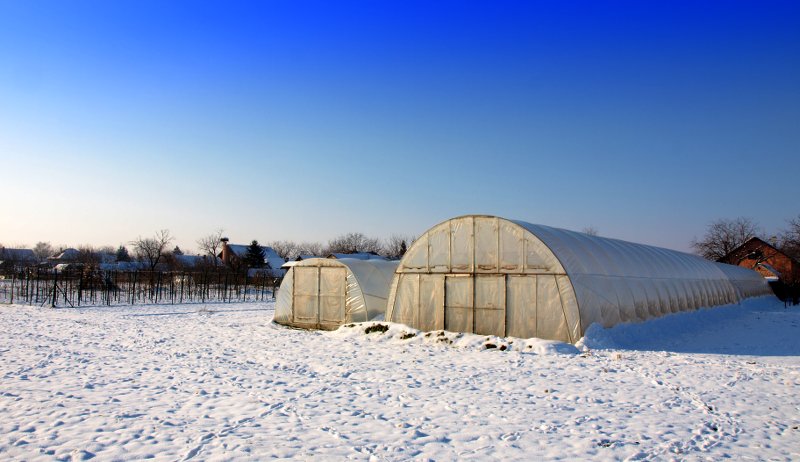
Interest in winter gardening is growing each year. The U.S. Department of Agriculture’s Natural Resources Conservation Service continues to assist farmers with purchasing high-tunnels, while winter growing technologies become more affordable and efficient. But there is a lot more to winter gardening than the infrastructure that makes it possible. You also must consider the elements.
Wind and cold, mud and frost: The winter is a diverse time for weather. Today I offer ideas for what to expect from growing over winter and how to prepare for it. Some might be obvious (cold, for instance), but others maybe not so much (heat and pests come to mind). To be clear, this article doesn’t aim to discourage anyone from winter gardening—it can be a truly delicious, profitable and bounteous time—but if you plan to give it a shot, it helps to know what you’re up against.
Mud
Without ample sunshine or hungry plants to suck it up, rain has no reason to leave the soil, often creating a muddy situation. For me, mud is the No. 1 challenge to late fall, early spring and overwinter farming. A good pair of boots will help in this area, but any areas where you walk often in the garden could benefit from heavy mulching.
Rain & Ice
In the summer, rain is a nuisance, but in the winter when the temperatures are lower, rain can be outright dangerous. For one, it can easily saturate your rain gear and quickly lower your body temperature while you’re working. Winter rain can freeze overnight on trees and fences, causing much damage. Animals have been known to be frozen to the ground in particularly bad ice storms. Any sort of outdoor row cover you have over crops might freeze as well, smothering your plants or making it difficult to remove. If you time your harvest around the weather and not the calendar, however, you can harvest on days of the week where everything is thawed. While winter gardening, it is good to have some ice salt on hand (for roads and paths) and some good rain gear if you will be working outside often. Also, if you have fencing against the woods, a chainsaw for clearing debris might not be a bad idea either.
Low Daylight
Heat isn’t the only trigger for growth. Sunlight in most cases is far more important. And through most of the winter, and for most in the continental United States, the amount of sunlight we receive can decrease to around half of what it is during the summer. That means that most plants will grow half as fast during the winter as they will in the summer. This light be augmented in winter gardening with grow lights and heaters, but daylight should definitely be taken into consideration when planing multiple harvests over winter. However, one upside that people don’t often realize is that the sun starts to come back strong in February and March, making way for faster growing in protected environments (high tunnels and greenhouses, for instance). Take advantage of that where possible, and get to market earlier than the competition.
Cold
No surprise here, but it’s easy to forget: During cold, you will have to store what you harvest. Just packing crops away in your truck overnight might not be as viable as it is during the summer. Your coolers also must be insulated to stay above freezing. It can get complicated for bigger operations, so consider that. As it is with ice, you should work based more on the weather than on your calendar to avoid harvesting in less-than-ideal conditions. Winter gardening, in other words, requires slightly more improvisation and adaptability.
Wind
Wind is a nuisance any time of year, but especially for winter gardening. Wind will dry out lettuce as you harvest it, it will rip up row cover, and just generally it will make a mess of things. My advice here: Simply set up your farm in a way that you are prepared for worse wind than you generally receive. Without the summer foliage to help block it, you will need to be as prepared as possible for unhindered gusts.
Pests
Although most of the bugs are gone, the deer and rabbits will smell your fresh produce and come from everywhere. Or at least, that’s what it feels like. Be sure to cover your produce well and keep your fencing hot. Where forage is abundant in the growing season, come winter the local fauna will zero in on your gardens.
Disease
Cold and wet is the favorite combination of many aggressive fungi. Be prepared to fight some disease and make sure that, on nice days, you can allow for additional airflow to your plants by opening up the sides of high or low tunnels.
Heat
Lastly, not all winters are cold. Some are warmer than others, and some just have extremely warm spells. It is in those moments of winter that the farmer really must think about how his or her crops are handing the excessive heat. This might require opening up your hoop house to allow heat to escape or even uncovering certain crops.
Winter is a very interactive time to be a gardener, so make sure you consistently consider next week’s weather forecast and plan based on that rather than what February and January are typically like. Because, honestly, there is nothing typical about growing in the winter.




